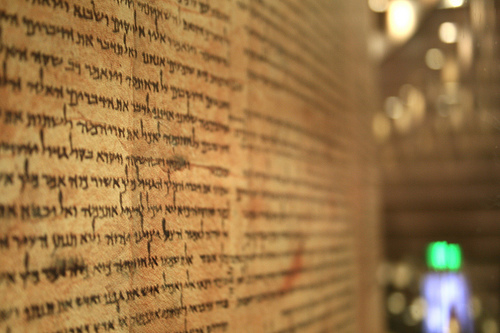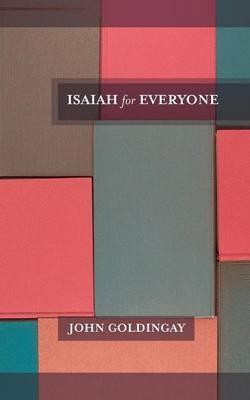The Book of Isaiah

(A photo of the Great Isaiah Scroll - part of the Dead Sea Scrolls)
This week we are starting a teaching series on the Book of Isaiah. Isaiah is the largest of the written prophets in the Old Testament and it is second only to Psalms in the number of times it is referenced in the New Testament. Our hope is that during this series you will gain a deeper appreciation for this amazing book and will recognize ways in which it speaks to us today. The book of Isaiah covers tumultuous times in the history Israel and addresses themes of Judgement, Comfort, and Hope.
This series is a great opportunity for us to read through the whole book. You might like to join our young people in reading a chapter a day. Or you might like to use our daily readings at encounterbc.org or our iphone app where we start reading Isaiah on Thursday 22nd June.
Commentaries can aid our understanding of the bible. "Isaiah for Everyone", is a commentary by John Goldingay. It is short and accessble which means you don't need a theology degree to understand it. We have a couple of physical copies available for loan so please see David or Paul if you would like to borrow a copy.

It is also available as a Kindle ebook.
Here is an excerpt from the Introduction:
(The books of the Old Testament are) not “old” in the sense of antiquated or out-of-date; I sometimes like to refer to them as the First Testament rather than the Old Testament to make that point. For Jesus and the New Testament writers, they were a living resource for understanding God, God’s ways in the world, and God’s ways with us. They were “useful for teaching, for reproof, for correction, and for training in righteousness, so that the person who belongs to God can be proficient, equipped for every good work” (2 Timothy 3: 16–17). They were for everyone, in fact. So it’s strange that Christians don’t read them very much. My aim in these volumes is to help you do so. My hesitation is that you may read me instead of the Scriptures. Don’t fall into that trap. I like the fact that this series includes much of the biblical text. Don’t skip over it. In the end, that’s the bit that matters......
An Outline of the Old Testament
The Christian Old Testament puts the books in the Jewish Bible in a distinctive order:
-
Genesis to Kings: A story that runs from the creation of the world to the exile of Judahites to Babylon
-
Chronicles to Esther: A second version of this story, continuing it into the years after the exile
-
Job, Psalms, Proverbs, Ecclesiastes, Song of Songs: Some poetic books
-
Isaiah to Malachi: The teaching of some prophets
Here is an outline of the history that lies at the books’ background. (I give no dates for events in Genesis, which involves too much guesswork.)
1200s Moses, the exodus, Joshua
1100s The “judges”
1000s King Saul, King David
900s King Solomon; the nation splits into two, Ephraim and Judah
800s Elijah, Elisha
700s Amos, Hosea, Isaiah, Micah; Assyria the superpower; the fall of Ephraim
600s Jeremiah, King Josiah; Babylon the superpower
500s Ezekiel; the fall of Judah; Persia the superpower; Judahites free to return home
400s Ezra, Nehemiah
300s Greece the superpower
200s Syria and Egypt, the regional powers pulling Judah one way or the other
100s Judah’s rebellion against Syrian power and gain of independence
000s Rome the superpower
Isaiah is the first of the great prophetic books, though Isaiah was not the first of the great prophets. The first to have a book named after him was Amos. Neither did prophets such as Amos and Isaiah fulfill their ministries by writing books. Prophets fulfilled their ministry by showing up in a public place such as the temple courtyards in Jerusalem and declaiming to anyone who would listen and also to the people who didn’t wish to listen. You can get an idea from reading the book of Jeremiah, which includes a number of stories about Jeremiah doing so, or from reading the Gospels, which portray the prophet Jesus doing so. Isaiah 8 and Jeremiah 36 include accounts of how these prophets came to have some of their messages written down, and it wouldn’t be surprising if the actual books of Isaiah and Jeremiah ultimately go back to these acts of writing down.
The fact that the material in a book such as Isaiah goes back to prophetic preaching explains the way the book doesn’t unfold in a systematic way like a normal book. It’s a collection of separate messages that have been strung together. Often the same themes recur, as they do in Jesus’ parables, because the same themes recurred in the prophet’s preaching. There’s a story about a Christian preacher whose people accused him of always repeating the same message; when they took notice of that one, he responded, he would preach another.
But the fact that the book is a compilation of prophetic messages doesn’t mean it has no structure. At a macro level, it’s rather clearly arranged.
-
Isaiah 1–12: Messages about Judah and Jerusalem, with references to King Ahaz
-
Isaiah 13–23: Messages about the nations around, with a reference King Ahaz
-
Isaiah 24–27: Messages about the destiny of the world around, with no reference to specific kings
-
Isaiah 28–39: Messages about Judah and Jerusalem, with references to King Hezekiah
-
Isaiah 40–55: Messages about Judah and Jerusalem, with references to King Cyrus
-
Isaiah 56–66: Messages about Judah and Jerusalem, with no reference to specific kings
One feature emerging from this outline is that at the macro level the book is arranged chronologically. Ahaz was king of Judah about 736(BC) to 715(BC). Hezekiah was king about 715(BC) to 686(BC). The last part of Isaiah 28—39 looks forward to the fall of Jerusalem and the exile of its leadership to Babylon, which happened in 587(BC). Cyrus was the king of Persia who took over the Babylonian empire in 539(BC) and allowed the Judahites in Babylon to go back home and rebuild the temple. The last chapters of the book make sense when understood in relation to the community in Judah after that event.
photo credit: KOREphotos Scroll of Isaiah from Qumran at Israel Museum via photopin (license)
David Wanstall, 14/06/2017